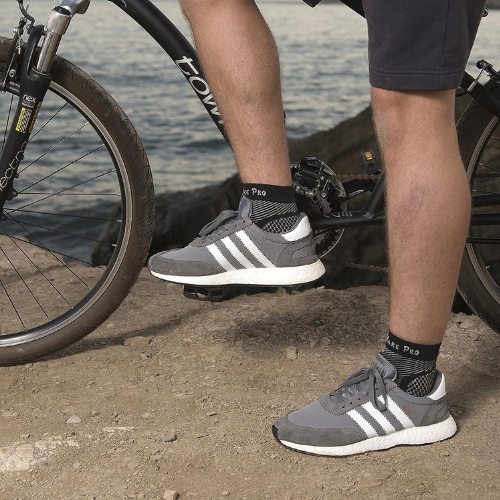
You've likely seen athletes wearing those skin-tight compression pants, sleeves, or shirts and wondered what the fuss was all about. Sure, they provide support and help prevent injuries, but there's a whole lot more to compression gear than meets the eye. From improved circulation to faster recovery times, these snug-fitting garments pack a powerful punch when it comes to boosting your performance and well-being. So let's dive into the world of compression wear and discover why it's become a staple for athletes and fitness enthusiasts alike.
One of the most significant benefits of compression gear is its ability to improve blood flow and oxygen delivery to your muscles. When you exercise, your muscles work harder, requiring more oxygen and nutrients to function optimally. Compression garments apply gentle pressure to your limbs, which helps to pump blood back towards your heart more efficiently. This increased circulation means your muscles receive a steady supply of oxygen and nutrients, allowing them to work at their best for longer periods.
Have you ever experienced that dreaded post-workout soreness? You know, the kind that makes it feel like you've been hit by a truck? Well, compression gear can help alleviate that discomfort. The compression helps to flush out lactic acid, which is a byproduct of intense exercise and a major contributor to muscle soreness. By promoting better circulation and lymphatic drainage, compression wear can speed up the removal of lactic acid, reducing the severity and duration of delayed onset muscle soreness (DOMS).
Compression gear isn't just for the workout itself; it can also aid in your recovery process. After an intense training session, your muscles can become inflamed and swollen due to tiny tears in the muscle fibers. Compression garments help to minimize this swelling by applying gentle pressure, which can reduce inflammation and hasten the recovery process. This means you'll be able to bounce back more quickly and hit the gym or field again sooner.
If you've ever struggled with muscle fatigue during a long run or intense workout, compression gear could be your new best friend. By improving circulation and oxygen delivery to your muscles, compression garments can help delay the onset of muscle fatigue. This means you can push harder and go longer without feeling like your muscles are about to give out. Plus, the added support and stability provided by compression wear can help reduce muscle vibration, which also contributes to fatigue.
Compression gear isn't just for athletes; it can also benefit those with certain medical conditions. For example, people with poor circulation or lymphedema (a condition where lymph fluid builds up in the body's tissues) can benefit from the improved circulation and lymphatic drainage provided by compression garments. Additionally, compression stockings are often recommended for individuals at risk of deep vein thrombosis (DVT), a potentially life-threatening condition caused by blood clots in the legs. It’s important to discuss compression wear as an option with your doctor to see if it’s right for you.
When it comes to choosing the right compression gear, it's essential to find the right level of compression for your needs. Compression levels are typically measured in millimeters of mercury (mmHg), with higher numbers indicating more compression. For general athletic use, a compression level between 15-30 mmHg is recommended. However, if you have a specific medical condition, it's best to consult with a healthcare professional to determine the appropriate compression level.
One of the common misconceptions about compression gear is that it's only for elite athletes or serious fitness enthusiasts. However, that couldn't be further from the truth. Whether you're a weekend warrior or just starting your fitness journey, compression wear can benefit you in numerous ways. From improved performance and recovery to increased comfort and support, these versatile garments can be a valuable addition to any active lifestyle.
Speaking of comfort, compression gear is designed to provide a snug, supportive fit without restricting your movement. The compression helps to stabilize your muscles, which can reduce the risk of injury during high-impact activities like running or jumping. Additionally, many compression garments are made with moisture-wicking fabrics that help keep you cool and dry, ensuring you stay comfortable throughout your workout or activity.
While compression gear can certainly enhance your athletic performance, it can also be a valuable tool for everyday activities. If you spend long hours on your feet or have a job that requires a lot of standing or walking, compression socks or tights can help alleviate discomfort and fatigue. The improved circulation and support provided by compression wear can make a world of difference when it comes to keeping your feet feeling fresh and energized.
One of the lesser-known benefits of compression gear is its ability to improve proprioception, which is your body's awareness of its position and movement in space. By providing a snug, supportive fit, compression garments can enhance your proprioception, allowing you to move with greater control and coordination. This can be particularly beneficial for activities that require precise movements, such as yoga, Pilates, or even everyday tasks like walking or climbing stairs.
Choosing the right compression gear is important. You want to consider the activity you'll be using it for. For high-impact activities like running or CrossFit, you'll want to opt for compression tights or shorts that provide full-leg support. For lower-impact activities like cycling or weightlifting, compression sleeves or arm warmers may be a better choice. And don't forget about compression socks, which can be worn during any activity to promote better circulation and reduce fatigue.
Incorporating compression gear into your workout routine or daily activities can be a game-changer, but it's important to remember that it's not a magic solution. Proper warm-up, cool-down, and recovery practices are still essential for optimal performance and injury prevention. Think of compression wear as a valuable tool in your fitness arsenal, but don't neglect the other essential components of a well-rounded training regimen.
As with any new addition to your fitness routine, it's important to ease into wearing compression gear. Start with shorter periods of wear and gradually increase the duration as your body adjusts. Additionally, be sure to follow the care instructions for your compression garments to ensure they maintain their compression and support over time.
Compression gear can provide many benefits, it's also important to listen to your body and adjust as needed. If you experience any discomfort, numbness, or tingling while wearing compression garments, remove them immediately and consult with a healthcare professional. Remember, compression wear is meant to enhance your performance and well-being, not cause discomfort or harm.
In the world of fitness and athletics, every little advantage can make a big difference. By incorporating compression gear into your routine, you're giving yourself a powerful tool to improve performance, enhance recovery, and support your overall well-being. From improved circulation and reduced muscle fatigue to increased comfort and support, compression wear offers a multitude of benefits that can take your training and activities to the next level.
Compression gear has come a long way from its humble beginnings as a simple support garment. Today, these snug-fitting garments are a staple in the fitness and athletic communities, offering a wide range of benefits that can enhance your performance, recovery, and overall well-being. Whether you're a seasoned athlete or just starting your fitness journey, embracing the power of compression wear can be a game-changer. So why not give it a try and experience the benefits for yourself? Your muscles (and your performance) will thank you.


Comments (0)
Back to Be Active - Stay Active